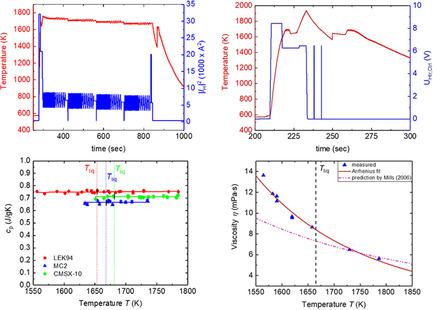当前位置:
X-MOL 学术
›
Adv. Eng. Mater.
›
论文详情
Our official English website, www.x-mol.net, welcomes your
feedback! (Note: you will need to create a separate account there.)
Thermophysical Properties of Advanced Ni‐Based Superalloys in the Liquid State Measured on Board the International Space Station
Advanced Engineering Materials ( IF 3.4 ) Pub Date : 2019-12-17 , DOI: 10.1002/adem.201901228 Markus Mohr 1 , Rainer Wunderlich 1 , Yue Dong 1 , David Furrer 2 , Hans-Jörg Fecht 1
Advanced Engineering Materials ( IF 3.4 ) Pub Date : 2019-12-17 , DOI: 10.1002/adem.201901228 Markus Mohr 1 , Rainer Wunderlich 1 , Yue Dong 1 , David Furrer 2 , Hans-Jörg Fecht 1
Affiliation

|
Advanced nickel‐based superalloys combine excellent high‐temperature mechanical strength, creep resistance, and toughness, and therefore find applications in next‐generation aircraft engines and turbines for land‐based power generators. The related fabrication processes are complex, time consuming, and costly, making it necessary to perform supporting computer simulations of the heat and material flow in the melt before and during crystallization. Such models are based on reliable thermophysical property data in the solid and liquid phase. However, measurements of surface‐ and volume‐dependent properties, such as liquid surface tension, viscosity, and specific heat of these complex liquid metal alloys, are very challenging, due to the melts high chemical reactivity at temperatures of interest. The method of choice is electromagnetic levitation, a containerless method. The measurements of surface tension, viscosity, mass density, and specific heat capacity, performed in the electromagnetic levitator (EML) on board the Space Laboratory Columbus in the International Space Station (ISS), are presented and discussed.
中文翻译:

在国际空间站上测量的液态高级镍基高温合金的热物理性质
先进的镍基高温合金具有出色的高温机械强度,抗蠕变性和韧性,因此可在陆基发电机的下一代飞机发动机和涡轮机中找到应用。相关的制造过程复杂,耗时且昂贵,使得有必要在结晶之前和期间对熔融物中的热量和材料流进行支持的计算机模拟。这样的模型基于固相和液相中可靠的热物理性质数据。但是,由于这些熔融金属在所关注的温度下具有很高的化学反应性,因此测量与表面和体积相关的特性(例如这些复杂的液态金属合金的液体表面张力,粘度和比热)非常具有挑战性。选择的方法是电磁悬浮,一种无容器的方法。介绍并讨论了在国际空间站(ISS)的太空实验室哥伦布上的电磁悬浮器(EML)中执行的表面张力,粘度,质量密度和比热容的测量。
更新日期:2019-12-17
中文翻译:

在国际空间站上测量的液态高级镍基高温合金的热物理性质
先进的镍基高温合金具有出色的高温机械强度,抗蠕变性和韧性,因此可在陆基发电机的下一代飞机发动机和涡轮机中找到应用。相关的制造过程复杂,耗时且昂贵,使得有必要在结晶之前和期间对熔融物中的热量和材料流进行支持的计算机模拟。这样的模型基于固相和液相中可靠的热物理性质数据。但是,由于这些熔融金属在所关注的温度下具有很高的化学反应性,因此测量与表面和体积相关的特性(例如这些复杂的液态金属合金的液体表面张力,粘度和比热)非常具有挑战性。选择的方法是电磁悬浮,一种无容器的方法。介绍并讨论了在国际空间站(ISS)的太空实验室哥伦布上的电磁悬浮器(EML)中执行的表面张力,粘度,质量密度和比热容的测量。











































 京公网安备 11010802027423号
京公网安备 11010802027423号